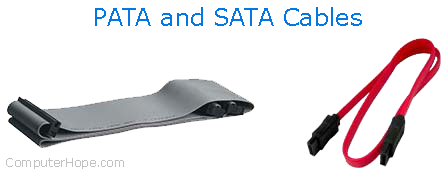Advantages of SATA over PATA
There are two types of hard drive connections that a computer could have: PATA (Parallel AT Attachment), also known as IDE (integrated drive electronics), and SATA (Serial AT Attachment). SATA is most commonly used in nearly all computers today, due to below advantages.
Advantages
Increased data transfer rate
The primary reason SATA is used over PATA is because of the increased data transfer speeds with that SATA. PATA can transfer speeds of 66/100/133 MBs/second, whereas SATA can transfer 150/300/600 MBs/second. The speed differences are due to the various flavors of PATA and SATA, with the fastest speeds being the latest version of each currently available. You'll notice that SATA's slowest speed is still faster than PATA's fastest speed. The improved speed of SATA allow programs to load faster, and pictures and larger documents to open faster. For video game enthusiasts, faster data transfer speeds can mean better gaming experiences (i.e., smoother game-play).
Easy cable management and cable length
Another advantage of SATA over PATA is the length of the cable connecting the hard drive to the computer motherboard. The max length of a PATA cable is 18-inches, whereas a SATA cable can be up to 3.3 feet (1 meter) in length. With this extra length, you have more flexibility of where a hard drive can be mounted in a computer case.

Increased airflow
SATA cables are also smaller in size than a PATA cable, allowing for increased airflow inside the computer case and decreased heat build-up. Better airflow helps improve the overall life of a computer.
Support for more drives
There are four to six SATA connections on a computer motherboard, allowing for multiple SATA hard drives to be hooked up. There are usually only two PATA connections on a computer motherboard that supports a total of four PATA hard drives.
Disadvantages
Drivers and support
There are only a few small disadvantages of SATA over PATA. One disadvantage is that SATA hard drives sometimes require a special device driver for the computer to recognize and use the drive. However, a SATA hard drive can act as a PATA hard drive, thus eliminating the need for the specific driver to be loaded. However, some SATA functionality is lost to gain this mimic functionality.
Older operating systems such as Windows 95 and 98 that were released long before SATA was introduced do not support SATA drives.
One drive per cable
Another disadvantage with SATA is that the cable allows only one SATA hard drive to connect at a time. Whereas a PATA cable allows two PATA hard drives per cable.
